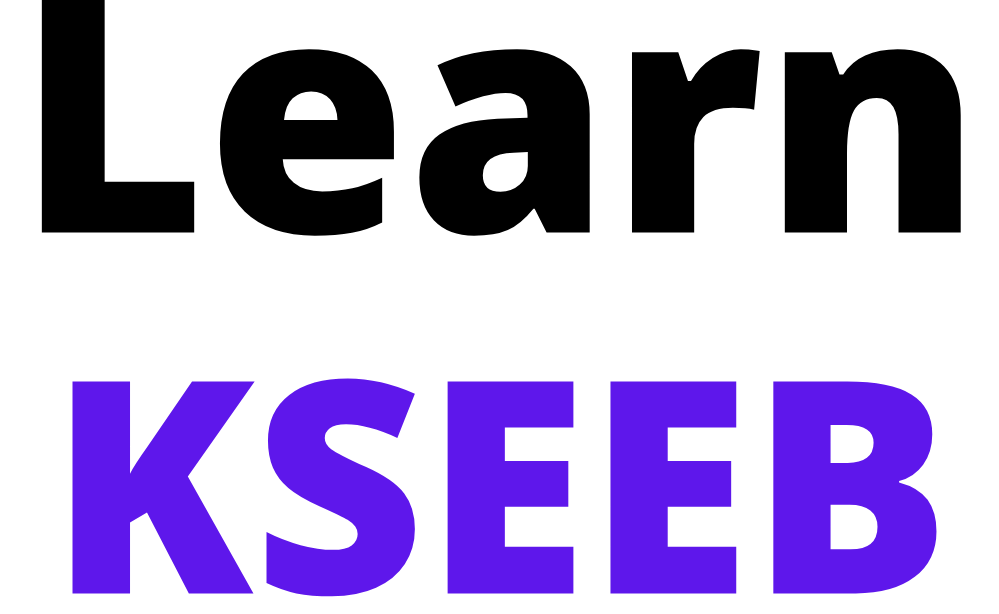KSEEB Class 9 Science Notes for Chapter 8 Motion Important Concepts
Rest
A body is said to be at rest if its position does not change with respect its surroundings
Motion
A body is said to be in motion if its position changes with respect to its surroundings.
Reference Point
It is a fixed point with respect to which a body is at rest or in motion.
Distance
It is the length of the actual path travelled by a body in a given interval of time.
Displacement
It is the shortest distance between the initial and final positions of a body in a specified direction.
Read and Learn More KSEEB Solutions for Class 9 Science
Scalar Quantities
These are the physical quantities which have only magnitude and no direction. Ex: speed, mass, temperature, energy, work, etc
KSEEB Class 9 Science Notes for Chapter 8 Motion
Vector quantities
These are physical quantities with both magnitude and a specified direction. Ex: velocity, force, acceleration, momentum, etc
Uniform motion
The motion of a body is said to be uniform if it covers equal distances in equal intervals of time however small the time intervals.
| Class 9 Social Science | Class 9 Science | Class 9 Maths |
Non-uniform motion
The motion of a body is said to be non-uniform if it covers unequal distances in equal intervals of time however small the time intervals
Speed
It is the distance travelled by the body divided by the time taken to cover the distance OR it is the distance travelled by a body in unit time (per second)
S.I unit is meter per second (m/s or\( \mathrm{ms}^{-1}\))
Class 9 KSEEB Science Chapter 8 Motion Notes

Uniform speed
The speed of a body is said to be uniform if the body covers equal distances in equal intervals of time.
Non-uniform speed
The speed of a body is said be non-uniform if the body covers unequal distances in equal intervals of time.
Average speed
It is the total distance travelled by a body divided by total time taken by the body to cover the distance.
Velocity
- It is a displacement of a body divided by the time taken to cover the displacement Or
- It is the displacement of a body per second Or
- It is the distance travelled by the body in one second in a given direction
S .1 unit is metre per second (m/s or \(\mathrm{ms}^{-1}\))
Uniform Velocity
The velocity of a body is said to be uniform if the body covers equal distances in equal intervals of time however small the time intervals in a given direction.
Variable Velocity
The velocity of a body is said to be variable if magnitude or direction or both of magnitude and direction of velocity change.
Average velocity
It is not displacement covered by the body divided by the total time taken.
Acceleration
It is the rate of change of velocity of a body with respect to time Acceleration
S.I unit is \(\mathrm{m} / \mathrm{s}^2 \text { or } \mathrm{ms}^{-2}\)
KSEEB Solutions for Class 9 Science Chapter 8 Motion
Positive Acceleration
Acceleration of a body is said to be positive if it takes place in the direction of the velocity of the body. In this case, velocity increases with time.
Negative Acceleration
Acceleration of the body is said to be negative if it takes place opposite to the direction of the velocity of the body. In this case, velocity decreases with time. It is also known as retardation or deceleration.
Uniform Acceleration
If the change in the velocity of a body in equal intervals of time is always the same, then an acceleration of the body is said to be the uniform acceleration
Variable Acceleration
If the change in the velocity of a body in equal intervals of time is not the same, then the acceleration of the body is said to be the variable acceleration
Graphs
It is a convenient method of presenting basic information of the motion of an object
Distance – Time Graph
- It is the graph which represents the change in the position of the object with respect to time. It may be linear or non-linear
- It is obtained by taking time (t) along the x-axis and distance (s) along the y- axis
- The slope of the graph gives the speed of the body in a given time interval
Displacement – Time Graph
- The graph was obtained by taking time along the x-axis and displacement along the y-axis. It is always a straight line (linear)
- The slope of the graph gives the velocity of the body
Velocity – Time Graph
- It represents the change in velocity with respect to time.
- It is obtained by taking time(t) along the x-axis and velocity (v) along the y-axis
- The graph may be linear or non-linear
- The slope of the graph gives the acceleration of the body and the area under the curve gives the distance travelled by the body in the given interval of time.
Equations Of Motion
The motion of a body with uniform acceleration can be described by the following three equations
(1) u = v + at
(2) s=ut +1/2 at²
(3) 2as = v2 – u2
where u – Initial velocity, v = final velocity, a ~ acceleration, s = distance and t = time
Uniform circular motion
- When a body moves in a circular path with constant speed, then the motion of the body is said to be uniform circular motion.
- In uniform mo ion, velocity is variable due to changes in direction continuously. The magnitude of the velocity is given by
the circumference of the circular path.
where r=radius of the circular path and T – time taken to cover the path once.
KSEEB Class 9 Science Notes for Chapter 8 Motion
Exercises
Question 1. An object has moved through a distance. Can it have zero displacements? If yes, support your answer with an example.
Answer: Yes. Suppose a student throws a ball to a height and catches it.
Distance travelled by the ball = h + h = 2h m
Displacement = 0.
Question 2. A farmer moves along the boundary of a square field of side 10m in the 40s. What will be the magnitude of displacement of the
farmer at the end of 2 minutes 20 seconds from his position?
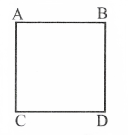 Answer: Consider the square field ABCD as shown in the figure. Given that fanner covers the boundary ABCD in 40 s. If he walks for 2 minutes and 20 seconds, he will be at point C.
Answer: Consider the square field ABCD as shown in the figure. Given that fanner covers the boundary ABCD in 40 s. If he walks for 2 minutes and 20 seconds, he will be at point C.
Thus magnitude of the displacement of the farmer
= AC
=√(AB)² + (BC)²
=√10² +10²
= √100+100
= √200
=14.14 m
Karnataka Board 9th Science Chapter 8 Notes PDF
Question 3. Which of the following is true for displacement?
(1)It cannot be zero
(2)Its magnitude is greater than the distance travelled by the object
Answer: Both statements are false
Question 4. Distinguish between speed and velocity
Answer:
Speed
1. It is the distance travelled by the body in one second irrespective of direction.
2. It is a scalar quantity
3. It is always positive
Velocity
1. It is the distance travelled by a body in one second in the given direction.
2. It is a vector quantity
Question 5.Under what condition(s) is the magnitude of the average velocity of an object equal to its average speed?
Answer: When a body moves along a straight path in the same direction, its total path length is equal to the magnitude of the displacement. Under this condition, average velocity is equal to average speed.
Question 6. What does the Odometer of an automobile measure?
Answer: The odometer measures the distance travelled by automobile
Question 7. What does the path of an object look like when it is in uniform motion?
Answer: The path looks like a straight line
Question 8. During an experiment, a signal from a spaceship reached the ground station in five minutes. What was the distance of the spaceship from the ground station? The signal travels at the speed of light ie 3 x \0sm/s.
Answer: Given data, t = 5 minutes 300 second and
v = 3 x 10 m/s
Distance of the spaceship (s) = v
t = 3 x 108 x 300 = 9 x 10 10 m
Question 9. When will you say a body is in (1) uniform acceleration? (2) non-uniform acceleration?
Answer:
(1) If the change in velocity in equal intervals of time is always the same, then the body is said to be in uniform acceleration
(2) If the change in velocity in equal intervals of time is not the same, then the body is said to be moving with non-uniform acceleration
Class 9 Science Chapter 8 KSEEB Motion Notes PDF
Question 10. A bus decreases its speed from 80kmh1 in 5 s. Find the acceleration of the bus.
Answer:
Acceleration = (Final velocity – Initial velocity)/(time interval)
Initial velocity = 80km/h
Final velocity=60km/h
\(\frac{60 \times 1000}{3600}=\frac{50}{3}=16.67 \mathrm{~m} / \mathrm{s} \)Acceleration = \(\frac{16.67-22.22}{5}=-6.47 / 5=-1.11 \mathrm{~ms}^{-2}\)
Question 11. A train starting from a railway station and moving with uniform acceleration attains a speed of 40km 1 in 10 minutes. Find its acceleration
Answer:
Final Speed= 40 km/h= \(\frac{40 \times 1000}{3600}=\frac{100}{9}=11.11 \mathrm{~m} / \mathrm{s}\)
Initial Speed = 0 km/h
Acceleration = (Final velocity – Initial velocity)/(time velocity)
\(=\frac{11.11-0}{10 \times 60}=\frac{11.11}{600}=0.019 \mathrm{~m} / \mathrm{s}^2\)
Question 12. What is the nature of the distance-time graphs for uniform and non-uniform motion of an object?
Answer: For uniform motion, the distance-time graph is a straight line. For non-uniform motion, the distance-time graph is a curved line
Question 13. What can you say about the motion of an object whose distance-time graph is a straight line parallel to the time axis?
Answer: The object is at rest
KSEEB Science Notes Chapter 8 Motion With Solved Examples
Question 14. What can you say about the motion of an object if its speed-time graph is a straight line parallel to the time axis?
Answer: The body is moving with uniform motion ie uniform speed.
Question 15. What is the quantity which is measured by the area occupied below the velocity-time curve?
Answer: Displacement covered by the body in the given interval of time.
Question 16. A bus starting from rest moves with a uniform acceleration of 0.1 m/s2 for 2 minutes. Find
(1) the speed acquired
(2) the distance travelled
Answer: Given data: u=0, a=0.1 m/s2 t=2 minutes – 120 second
(1) The speed acquired (v) = u+at
\(=0+0.1 \times 120=12 \mathrm{~ms}^{-1}\)
(2) The distance travelled =\( u t+1 / 2 a t^2\)
\(=0 \times 120+1 / 2 \times 0.1 \times(120)^2\)
=720m
Question 17. A train is travelling at a speed of 90km/h. Brakes are applied so as to produce a uniform acceleration of 0.5 m/s2. Find how far the train will go before it is brought to rest.
Answer: Given data:
\(\begin{aligned}
&\mathrm{u}=90 \mathrm{~km} / \mathrm{h}=\frac{90 \times 1000}{3600}=25 \mathrm{~m} / \mathrm{s} \\
&\mathrm{a}=-0.5 \mathrm{~m} / \mathrm{s}^2, \mathrm{v}=0
\end{aligned}\)
We know that \(v^2-u^2=2 a s\)
\(\mathrm{s}=\frac{v^2-u^2}{2 a}=\frac{0^2-25^2}{2(-0.5)}=625 m\)
Question 18. A trolley while going down an inclined plane, has an acceleration of 2cm s’2. What will be its velocity 3s after the start?
Answer:
Given data: u = 0, a=3cm=0.03m, t=3sec.
Velocity after 3 sec = v=u+at \( =0+0.03 \times 3\)
\( =0.09 \mathrm{~m} / \mathrm{s}\)
Question 19. A racing car has a uniform acceleration of 4 m/s2. What distance will it cover in 10s after the start?
Answer:
Given data : \(\mathrm{u}=0, \mathrm{a} 4 \mathrm{~m} / \mathrm{s}^2, \mathrm{t}=10 \mathrm{~s}\)
Distance travelled after \( \begin{aligned}
&10 \mathrm{~s}=\mathrm{s}=u \mathrm{t}+1 / 2 \mathrm{at}^2 \\
&=0 \times 10+1 / 2(4)(10)^2 \\
&=200 \mathrm{~m}
\end{aligned}\)
Question 20. A stone is thrown in a vertically upward direction with a velocity of 5m/s. If the acceleration of the stone during its motion is 10ms’2 in the downward direction, what will be the height attained by the stone and how much time will it take to reach there?
Answer:
Given data: \(\mathrm{u}=5 \mathrm{~m} / \mathrm{s}, \mathrm{a}=-10 \mathrm{~m} / \mathrm{s}^2\)
At the height point v=0
Thus using the formula
\(\mathrm{s}=\frac{v^2-u^2}{2 a}=\frac{0^2-5^2}{2(-10)}=\frac{25}{25}=1.25 \mathrm{~m}\)
Thus the height attained by the stone = 1.25m
Now, v=u+at \( \begin{aligned}
\Rightarrow 0=5-10 \mathrm{t} & \Rightarrow \mathrm{t}=5 / 10 \\
&=0.5 \mathrm{~s}
\end{aligned}\)
Question 21. An athlete completes one round of a circular track of diameter 200m in the 40s. What will be the distance covered and displacement at the end of Z minutes 20s?
Answer: Time is taken to complete 1 round =40s
Total time taken = 2minutes+20s=140s
Total distance covered = (circumference of circularpath*total time taken)/(time taken to complete one round)
\(=\frac{\pi d \times 140}{40} \mathrm{~m}\)
\(=\frac{22}{7} \times 200 \times \frac{7}{2}=2200 \mathrm{~m}\)
After the 140s, the athlete will be in the exactly diametrically opposite position. (Why?)
Hence displacement = 200m
Question 22. Joseph jogs from one A to the other end B of a straight 300m road in 2 minutes 30 seconds and then turns around and jogs 100m back to point Cin another 1 minute. What are Joseph’s average speeds and velocities in jogging (a) from A to B and (b) from A to C
Answer:
Case (1): In jogging from A to B,
Distance covered = 300m and displacement = 300m(Why?)
Time taken = 2 minutes + 30s = 150s
Average Speed = (distance)/(time) =
\(\frac{300}{150}=2 \mathrm{~m} / \mathrm{s}\)
Average velocity = (displacement)/(time) =
\( \frac{300}{150}=2 \mathrm{~m} / \mathrm{s}\)
Case (2): In jogging from A to C
Distance travelled = 300 + 100 = 400m
Displacement = AB – BC = 300-100 = 200m
Time taken = 2 min 30s + 1 minute = 210s
Average Speed =(distance)/(time) =
\(=\frac{400}{210}=1.9 \mathrm{~m} / \mathrm{s}\)
Average velocity = (displacement)/(time)=
\(=\frac{200}{210}=0.95 \mathrm{~m} / \mathrm{s}\)
Question 23. Abdul while driving to school, computes the average speed for his trip to be 20kmh~1. On his return trip along the same route, there is less traffic and the average speed is 30km What is the average speed for Abdul’s trip?
Answer: Let the distance between Abdul’s house and school = X km
Time is taken in driving to school at a speed of
\(20 \mathrm{kmph}=\frac{\text { dis } \tan c e}{\text { time }}=\frac{x}{20} h\)
Time taken in returning at a speed 30kmph =\( \frac{x}{30} h\)
Total time is taken for the whole trip =
\(\frac{x}{20}+\frac{x}{30}=\frac{5 x}{60} h\)Average speed = (total distance)/(total time taken)
= \(\frac{2 x}{5 x / 60}=\frac{120}{5}=24 \mathrm{kmh}^{-1}\)
Question 24. A driver of a car travelling at 52k mb1 applies the brakes and accelerates uniformly in the opposite direction. The car stops in 5 s. Another car driver going at 34 knlr1 in another car applies his brakes slowly and stops in 10s. On the same graph paper, plot the speed versus time graphs for the two cars. Which of the two cars travelled farther after brakes were applied?
Answer: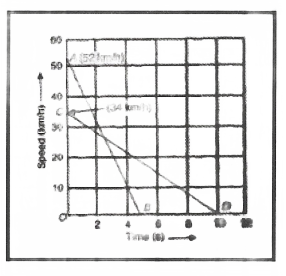
In the figure, AB and CD represent the speed versus time graphs for the two cars.
Distance travelled by the 1st car
\(\begin{aligned}
& =1 / 2 \times \mathrm{AB} \times \mathrm{AO} \\
& =1 / 2 \times \frac{52 \times 1000}{3600} \times 5 \\
& =36.1 \mathrm{~m}
\end{aligned}\)
Similarly, the distance travelled by the 2nd car =
\(\begin{aligned}
& =1 / 2 \times \mathrm{CO} \mathrm{CD} \\
& =1 / 2 \times \frac{34 \times 1000}{3600} \times 10
\end{aligned}\)
= 47.2 m
It is clear that the 2nd car travelled farther than the 1st car after breaks were applied.
Question 25. Fig 8.11 shows the distance-time graph of three objects A, B and C. Study the graphs
and answer the following questions :
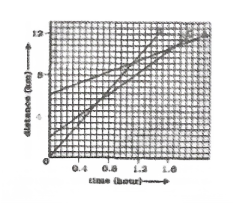 (1) Which of the three is travelling the fastest?
(1) Which of the three is travelling the fastest?
(2) Are all three ever at the same point on the road?
(3) How has C travelled when B passes A?
(4) How far has B travelled by the time it passes C?
Answer:
We know the slope of the distance-time graph represents the speed of the object.
(1) Steeper the graph, the greatest and B travels with the fastest speed
(2) Since there is no common point of intersection of the three lines, they are not at the same point ever on the road.
(3) From the graph, C has travelled a distance of about 9km
(4) Again from the graph, B has travelled about 6km
Question 26. A ball is gently dropped from a height of 20m. If its velocity increases uniformly at the rate of 10m/s2, with what velocity will it strike the ground? After what time will it strike the ground?
Answer:
Given data, u=0, h=20m, a = \(10 \mathrm{~m} / \mathrm{s}^2\), v = ?, t = ?
We
know that \( v^2-u^2=2 a h\)
\( v^2-0^2=2 \times 10 \times 20\)
\(v^2=400 \Rightarrow v=20 \mathrm{~m} / \mathrm{s}\)
Now we know that \( \mathrm{v}=\mathrm{u}+\mathrm{at} \Rightarrow\)
\(t=\frac{v-u}{a}=\frac{20-0}{10}=2 s\)
Question 27. The speed-time graph for a car is shown in figure 8.12.
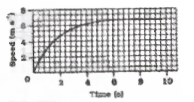
(1) Find how far the car travel in the first 4 seconds. Shade the area on the graph that represents the distance travelled by car during the period.
(2) Which part of the graph represents the uniform motion of the car?
Answer:
(1)Along time – axis, 5 squares = 2s
Along speed – axis, 3 squares = 2m/s
Area of 15 squares = Distance
\(=2 \mathrm{~s} \times 2 \mathrm{~m} / \mathrm{s}=4 \mathrm{~m}\)
Area of 1 square = distance pf 4/15m
The number of squares under the graph between 4s and 6m/s = \(\begin{gathered}
57+1 / 2(6) \\
=60
\end{gathered}\)
Hence distance travelled by the car = 60 x 4/15 = 16m
(2) The graph after 6s represents uniform motion since the graph remains flat
KSEEB 9th Science Chapter 8 Important Questions
Question 28.State which of the following situations are possible and give an example for each of these
(1) an object with constant acceleration but with zero velocity
(2) an object moving in a certain direction with an acceleration in the perpendicular direction.
Answer:
(1) When an object is thrown vertically upwards, at the highest point, velocity becomes zero but still it has acceleration which is equivalent to acceleration due to gravity.
(2) When an aeroplane moves horizontally, acceleration due to gravity acts on it perpendicular to the direction of the motion.
Question 29. An artificial satellite is moving in a circular orbit of radius 42250km. Calculate its speed it it takes 24 hours to revolve around the earth.
Answer:
Given data, Radius (R) = 42, 250km = 42250000m
Time period (T) = 24 h = \(24 \times 60 \times 60 \text { seconds }\)
Speed =
KSEEB Class 9 Science Notes for Chapter 8 Motion
Additional Questions
One Mark
Question 1. What is motion?
Answer: A body is said to be in motion if its position changes with respect to a reference point
Question 2. What is the simplest motion?
Answer: Motion along a straight line is the simplest motion
Question 3. Rest and motion are relative terms. Why?
Answer: An object at rest for one person is in motion for other people
Question 4. Give an example of directly perceivable
motion
Answer: Motion of a car on the road
Question 5. Give an example of an indirectly perceivable motion
Answer: Motion of the air observed due to the movement of dust or leaves of branches of a tree.
Question 6. Identify a scalar and vector from the
following
(1) distance
(2) displacement
Answer: distance – a scalar and Displacement – a vector
Question 7. Given an example for a uniform motion question
Answer:
1) Motion of the earth around the sun
2) Motion of a stone thrown vertically upwards
3) Motion of a train approaching a railway station
Question 8. Give two examples of non-uniform motion
Answer: It is the ratio of the total distance travelled to the time interval to cover the distance
Question 9. Define average speed
Answer: It is the ratio of net displacement to the time interval
Question 10. What do you mean by the term reference point?
Answer: An object or place specified to locate the position of an object is called a reference point.
Question 11. Define displacement of a body.
Answer: The shortest distance measured from the initial to the final position of an object is known as the displacement of a body.
Question 12. What is an odometer?
Answer: It is a device used in automobiles to measure the distance travelled.
Question 13. What is a point object?
Answer: An object whose size is very small compared to the distance travelled by the object is called a point object.
Question 14. What is the S.I. unit of displacement?
Answer: metre (m)
Question 15. Can displacement be greater than the distance of an object?
Answer: No. Displacement may be equal to or less than distance.
Question 16. How is the speed of an object measured?
Answer:
\(\text { speed }=\frac{\text { distance travelled }}{\text { total time taken }}\)
Question 17. A body moves from rest with uniform speed. What type of distance-tome graph do we set?
Answer: A straight line passing through the origin.
Question 18. What does the area under velocity – time graph represent?
Answer: The area enclosed by the velocity-time graph and the time axis represent the magnitude of the displacement.
Question 19. Under what condition average velocity of an object equal to its average speed?
Answer: If the object moves along a straight path
Question 20. What can a speed meter measure?
Answer: Instantaneous speed ie speed at the moment of observation.
Question 21. Define average velocity
Answer: It is the ratio of net displacement to total time taken.
Two Marks
Question 22. Define the uniform speed of a body
Answer: The speed of a body is said to be uniform, it covers equal distances in equal intervals of times
Question 23. Define uniform velocity
Answer: The velocity of the body is said to be uniform if it covers equal displacements in equal intervals of time in the given direction
Question 24. Define variable velocity.
Answer: When the magnitude or direction or both of velocity change then the velocity is called variable velocity.
Question 25.Mention S.I units of
(1) velocity
(2)acceleration
Answer: S.I unit of velocity is \( \mathrm{ms}^{-1}\)and the S.I unit of acceleration is \(\mathrm{ms}^{-2}\)
Question 26.Define uniform acceleration
Answer: Acceleration of a body is said to be uniform if changes in the velocity are equal in equal intervals of time
Question 27. Give an example of u uniformly acceleration motion
Answer: Motion of the freely falling body
Question 28. Define acceleration. Mention its S.I units
Answer: Acceleration is defined as the rate of change of velocity. S. I units are \(\mathrm{ms}^{-2}\)
Question 29. What do you understand by retardation of a body? Give an example
Answer: The rate of decrease of velocity is known as retardation or deceleration.
Example: When a stone is thrown upwards, its velocity decreases.
Question 30. Mention any two natural phenomena that occur due to motion.
Answer: Sunrise, Sunset, seasons etc.,
Question 31. Give an example for directly and indirectly perceivable motion.
Answer: The motion of a vehicle is directly perceivable motion. The motion of air is an indirectly perceivable motion
Question 32. When an object is thrown vertically upwards, it rises to a height of 10m – and returns to its initial position. What is the total distance travelled by the object? What is the displacement of the object?
Answer: Total distance travelled -10+10 = 20m
Net displacement = 0
Question 33. Name the type of the following motion
1)A man jogging in C part
2)Motion of around the earth.
Answer:
1) Non-uniform motion
2)uniform motion
KSEEB Class 9 Science Textbook Solutions Chapter 8
Question 34. When is the acceleration is taken as (a) +ve (b)-ve
Answer: When acceleration occurs in the direction of motion, then it is said to be positive. When acceleration occurs against the direction of motion, then it is said to be negative.
Question 35. The time interval between lightning and thunder is 1.5 seconds. Find the distance of lightning from the earth (speed of sound in air 343 m/s)
Answer: Distance of lightning = speed of lightning x time informed = 343 x 1.5
= 515.5m
Question 36.Draw a typical distance-time graph of an object moving with a uniform speed
Answer: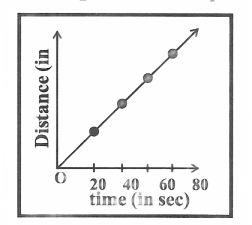
Question 37.Draw a typic distance-time graph of an object moving hm – a uniform speed
Answer:
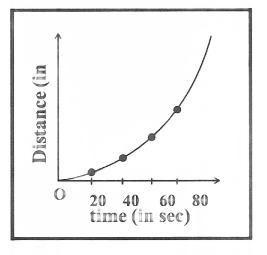
Question 38. What does the slope of the following graphs indicate?
1)displacement-time graph
2)velocity-time graph
Answer: Instantaneous speed is the speed at the moment of observation.
Three Marks Questions
Question 39.Mention any one use of
1)displacement time graph
2)velocity-time graph
Answer:
1) The slope gives a velocity of the body at any given instruction.
2) Area Enclosed by the graph gives the magnitude of the displacement of the curve.
Question 40. When the acceleration of a body is said to be
1) Positive
2) negative?
Answer: When the velocity of a body increases with time, then its acceleration is said to be positive. When the velocity of a body decreases with time, then its acceleration is said to be negative.
Question 41. Can an object have a constant acceleration with zero velocity? Give an example
Answer: Yes. An object can have a constant acceleration with zero velocity.
For example, when a stone is thrown up vertically, at the highest point velocity becomes zero but acceleration will be accelerated due to gravity.
Question 42. Uniform circular motion is an accelerated motion. Justify this statement
Answer: In a uniform circular motion, though the magnitude of velocity remains constant, its direction changes continuously. Hence, uniform circular motion is an accelerated motion.
Question 43. Write equations of motion
Answer:
(1) v = u + at
(2) s = \(u t+1 / 2 a t^2\)
(3)\( v^2=u^2+2 a s\)
where u – initial velocity, v = final velocity, a — acceleration, s = distance, t = time
Question 44. A moving car is brought to rest in 30 seconds after applying brakes. If the retardation rate is 2 m/s2, find the initial velocity of the car and the distance travelled by car.
Answer: Given t = 30s, v = 0, a = – \(2 \mathrm{~m} / \mathrm{s}^2\)
Using the equation v = u + at, we get 0 = u – 2
x 30 => u = 60 m/s
Question 45. Give an example for
1)accelerated motion in the direction of motion
2)accelerated motion opposite to the direction of motion
3)zero acceleration
Answer:
1) accelerated motion in the direction of motion
2)accelerated motion opposite to the direction of motion
3)zero acceleration
Question 46. The velocity-time graph for the motion of an object is given
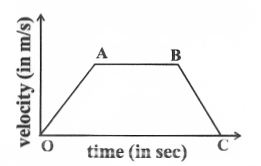
What type of motion the part
1)OA
2)AB
3)BC represent?
Answer:
1) OA represents uniformly accelerated motion
2)AB represents zero acceleration motion
3)non-uniformly accelerated motion.
Karnataka Board 9th Science Chapter 8 MCQs
Question 47.
1) Distinguish between distance and displacement.
2) Usha swims in a 90 m-long pool. She covers 180m in 1 minute by swimming from one end to another and back along the same straight path. Find the average speed and average velocity of Usha.
Answer:
Distance
- Distance is the actual path travelled by the body
- A scalar quantity
- Distance is always greater or equal to dis-placement
- The distance can be positive or zero
Displacement
- The shortest distance between an initial and final position of the body.
- A vector quantity
- Displacement is always equal to less than the distance
- Displacement can be +ve, -ve or zero.
b)\( \text { Average speed }=\frac{\text { Total distance travelled }}{\text { Total time taken }}\)
\( =\frac{180}{60} \mathrm{~ms}^{-1}\)
\( =3 \mathrm{~ms}^{-1}\)
Question 48. Prove that the area enclosed by the veloc¬ity-time graph and the time axis is equal to the magnitude of the displacement.
Answer:
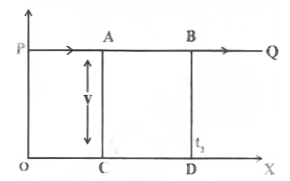
Consider car moving with uniform velocity V. The velocity-time graph PQ is a straight line parallel to the time axis as shown in fig.
Let A and B be the position of the car at the time t. and t2 respectively. W.K.T.
distance travelled the car – velocity x time
\(=v\left(t_2-t_1\right)\)
= AC x CD
S = Area of the rectangle ABDC then the distance travelled by car is equal the area enclosed by the velocity-time graph and time axis.
Question 49. From the following velocity-time graph of a car, find the distance travelled by the car from t = 10 to t = 20
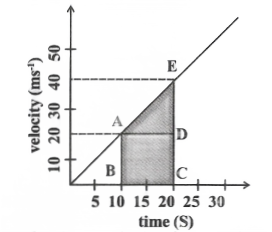
Answer: From the above velocity-time graph, the distance travelled by the car from t = 10S to 20S is given by
S = Area of rectangle ABCD + Area of triangle ADE
\(=(A B \times B C)+1 / 2 \times A D \times D E\)
AB = 20 \(\mathrm{~ms}^{-1}\)
BC = 10s
AD = AB = 10s
ED = CE – CD
= CE – AB
= 40 – 20
= \(20 \mathrm{~ms}^{-1}\)
\(S=(20 \times 10)+1 / 2 \times 10 \times 20\)
= 200 + 100
s = 300m
Question 50.Derive the equation of motion v = u + at using the v -1 graph
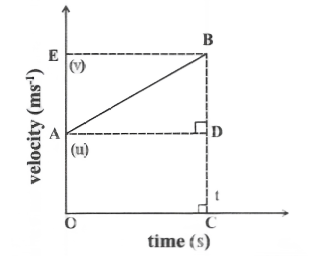
Answer: consider an object moving with uniform acceleration. Let ‘u’ be the initial velocity and 1 v’ be the final velocity of the object respectively.
The velocity-time graph is a straight line represented by AB. In the graph
OA = Initial velocity=u
OE – Final velocity = v
OC = Time interval = t
Draw AD || to OC
BC = BD + DC = BD + OA
substituting BC = V and OA=U
we get = BD + U
=> BD = V – U
the slope of the v -1 graph represents acceleration ie
\(a=\frac{\text { change in velocity }}{\text { time interval }}\)
\(a=\frac{v-u}{t}\)
at = v – u
\(\Rightarrow \quad v=u+\text { at }\)
Motion Class 9 KSEEB Question Answer
Question 51. Derive the equation of motion s = ut + at2 using a velocity-time graph.

Answer: consider an object moving with uniform acceleration ‘a’.
AB represents the velocity-time graph of the object in the time interval +’. In the graph
O A = Initial velocity=u
OE = Final velocity = v
OC = Time interval = t
If S is the distance travelled by the object isn’t a second, then
S = Area of trapezium OABC
=Area of the rectangle OADC + Area of the triangle ADB
\(=(\mathrm{OA} \times \mathrm{OC})+1 / 2(\mathrm{AD} \times \mathrm{BD})\)……….(1)
From the fig.
OA = u
OC = t
BC = BD + DC = BD + OA
v = BD + u \( \Rightarrow \mathrm{BD}=\mathrm{v}-\mathrm{u}\)
\(\text { acceleration }(a)=\frac{\text { change in velocity }}{\text { time }}\)
[/latex] a=\frac{\mathrm{v}-\mathrm{u}}{\mathrm{t}}=\frac{\mathrm{BD}}{\mathrm{t}}[/latex]
[/latex] \Rightarrow \mathrm{BD}=a \mathrm{t}[/latex]
substituting these values in equation(1)
Then [/latex]\mathrm{S}=\mathrm{u} \times \mathrm{t}+1 / 2 a t^2[/latex]
\(\mathrm{S}=u t+1 / 2 a t^2\)
Question 52. Derive the equation of motion 2as = v2 – u2 using the velocity-time graph.
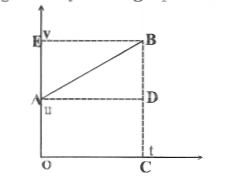
Answer: In the figure, AB represent the velocity-time graph for an object moving with uniform acceleration (a)
Let S be the distance travelled by the object in ‘t’ second.
S = Area enclosed by the v -t graph
ie S = Area of trapezium OABC
\(=1 / 2(\mathrm{OA}+\mathrm{BC}) \times \mathrm{OC}\)
Area of trapezium = \(1 / 2(a+b) h\)
\(S=1 / 2[u+v] \times t\) ………..(1)
From the velocity-time velocity ie v = u + at
\(\Rightarrow \mathrm{t}=\frac{v-u}{a}\)
substituting this value in Eqn (1)
\(\mathrm{S}=\frac{1}{2}(u+v) \times \frac{(v-u)}{a}\)
\(\Rightarrow 2 \mathrm{as}=\mathrm{u}^2-\mathrm{v}^2\)……….(2)
KSEEB Class 9 Science Notes for Chapter 8 Motion
Application Questions
Question 1. Can displacement of a body be zero?
Answer: Yes, If a body returns to its initial position, then
its displacement is said to be zero.
Question 2. The walls of your classroom are at rest. Justify.
Answer: When time passes, the walls do not change with respect to the floor or ceiling. Hence the walls at rest.
Question 3. A body moves along a circular path of radius R. What will be its distance and displacement when it sweeps 180°?
Answer: When the body sweeps 180°, it will be diametri¬cally opposite point. Hence.
\(.\text { distance }=1 / 2 \times \text { circumference }\).
\(=1 / 2 \times 2 \pi r=\pi r\)
displacement = diameter = 2r
Question 4. Can displacement be negative?
Answer: Yes, In retardation motion, displacement is said to be negative.
Free Notes For KSEEB Class 9 Science Chapter 8 Motion
Question 5. During the rainy day, we see lightning first and then hear thunder. Why?
Answer: The speed of light is greater than the speed of sound.
Question 6. What happens to an acceleration of an object when the force acting on it is doubled?
Answer: Since acceleration and the applied force acceleration doubles when the force is doubled.
Question 7.Velocity – time graph is parallel to the x-axis. What does this mean?
Answer: This means that the object is moving with constant velocity is zero acceleration.
Question 8. Mention the type of motion of a body from the following velocity-time graph
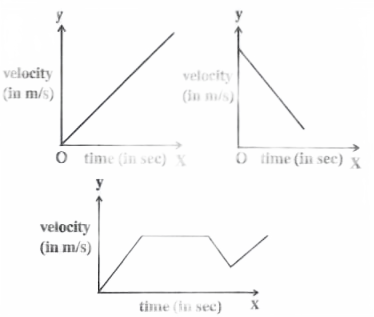
Answer: 1) uniformly accelerated motion
2)non-uniform retardation
3)non-uniformly accelerated motion
KSEEB Class 9 Science Chapter 8 Exercise Solutions
Question 9. An object moves such that the magnitude of velocity does not change but the direction changes continuously. What type of motion the object has?
Answer: Uniform circular motion.
Question 10. A girl travels from A to B towards the north from B she moves to C towards the east. Draw the resultant displacement in the diagram.
Answer:
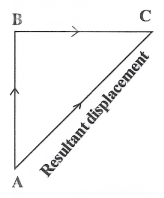
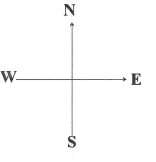
Question 11. Name the force that keeps an object in a uniform circular motion. What happens if the force vanishes suddenly?
Answer: Centripetal force keeps the object in a uniform circular motion. If the force vanishes, then the object moves in. a direction tangent to the circular path.
